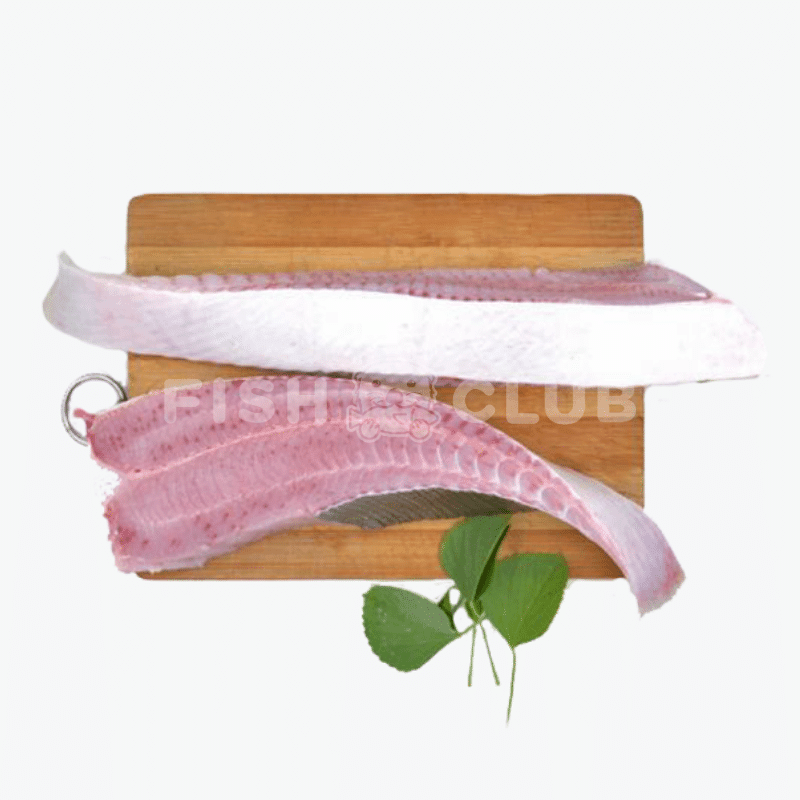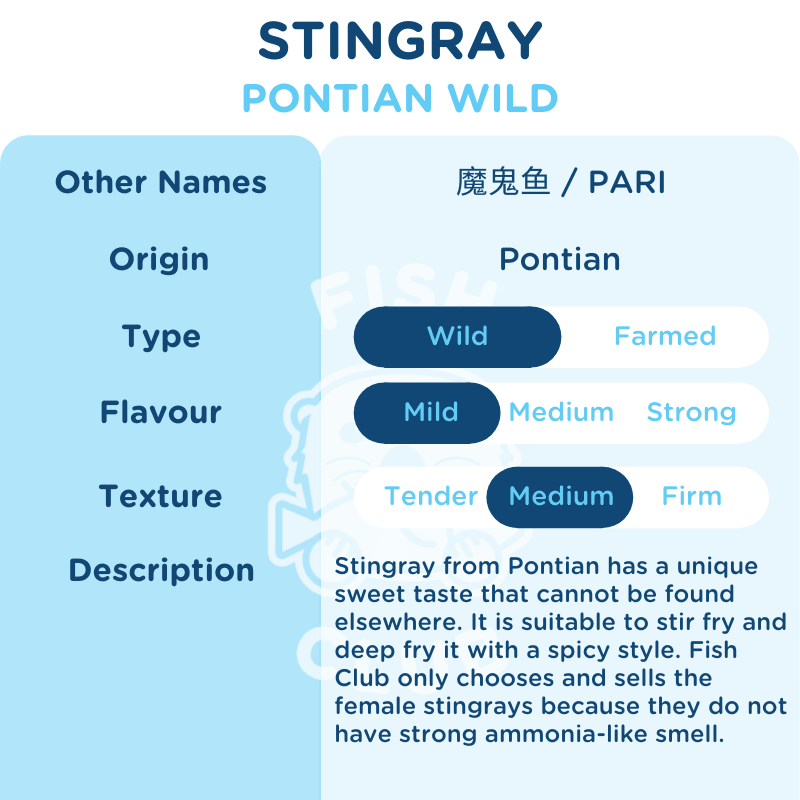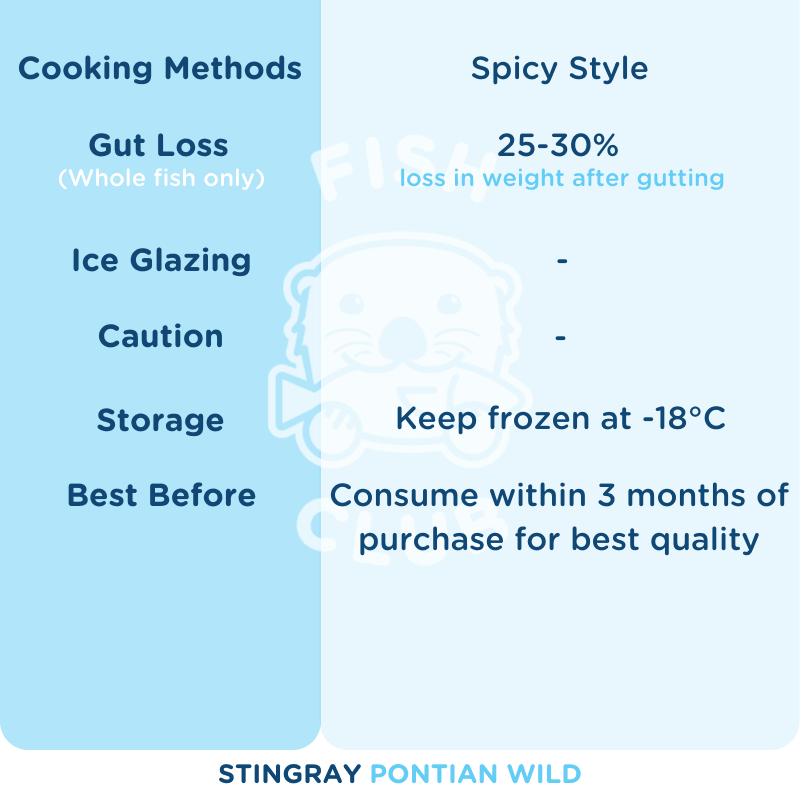Fish Club
Stingray (Pontian Wild) / 魔鬼鱼(笨珍野生)
Stingray (Pontian Wild) / 魔鬼鱼(笨珍野生)
SKU:PRI-S-500
Origin: Pontian
Out of stock
Couldn't load pickup availability
Stingray 魔鬼鱼
Stingray from Pontian has a unique sweet taste that cannot be found elsewhere. It is mild in flavour and medium in texture. It is suitable to stir fry and deep fry it with a spicy style. Fish Club only chooses and sells the female stingrays because they do not have strong ammonia-like smell like male stingrays. 笨珍野生的魔鬼有别于来自其他海域的魔鬼鱼,它的肉质中等,但是它的味道更加清甜。它适合翻炒和油炸,用来烹煮辛辣的食物。Fish Club 只挑选雌性魔鬼鱼售卖,因为它们不会像雄性魔鬼鱼带有强烈的氨味。
Chinese Name(s): 魔鬼鱼 / 鲂鱼 / 鯆鱼
Local Name(s): Pari / Tou Mak
Origin: Pontian 笨珍
Type: Wild Caught 野生
Flavour: Mild 清淡
Texture: Medium 中等
Cooking Method: Spicy Style 辛辣
Weight Loss after cleaning (whole fish): 25-30% ————————————————————————————————————
"These creatures are dangerous... but also dangerously delicious."
How To Make: Sambal Stingray in Banana Leaf

Ingredients
- 1 ounce (about 1/2 cup) dried red chilies
- 1ounces (about 1/2 cup) dried small shrimp (available in Asian markets)
- 10 to 12 large garlic cloves
- 8 to 10 shallots, peeled
- 3-inch piece ginger, peeled and coarsely chopped
- 3-inch piece lemon grass, white end, coarsely chopped
- 1 teaspoon belachan shrimp paste, available in Asian markets or 2 teaspoons fish sauce
- 1 tablespoon tamarind paste or lime juice, more to taste
- 2 tablespoons light brown sugar, more to taste
- ¼ cup raw peanuts
- 2 tablespoons vegetable oil, plus more for fish
- 1 whole, skinless skate wing, 1 1/2 to 2 pounds, or firm fillets like snapper, about 3/4-inch thick
- 3 banana leaves (available frozen at Asian and Latin markets)
- Slices of lemon, for garnish
- Slices of white onion, for garnish
- Sprigs of cilantro, for garnish
Steps
- Make the sambal: In separate bowls, soak the chilies and the dried shrimp in water to cover for 10 minutes, then drain. Remove and discard stems and seeds from the chilies.
- In a blender, combine the chilies, shrimp and remaining sambal ingredients, except the oil, with 1/2 cup water. Blend until finely chopped but not smooth. Heat the oil in a frying pan over medium heat and add the sambal. Cook, stirring often, until it is moist, thick and dark red, adding water 1 tablespoon at a time if needed to prevent scorching.
- Cook the fish: Rinse and dry the fish and sprinkle it with salt. Heat a grill to high, or place a heavy skillet (with a lid) over medium-high heat. Spread one side of the fish with a thin layer of sambal. Place a banana leaf on grill (or in skillet), drizzle lightly with vegetable oil and place the fish on top, sambal side up. Cover grill or pan and cook about 8 minutes, until the banana leaf is toasted and the sambal is dry and fragrant. Remove the leaf and fish from the heat. Place a new banana leaf on grill or in pan, drizzle it with oil, flip fish onto it and spread more sambal on top. Cover and cook another 6 to 8 minutes, until cooked through.
- Place another leaf on a platter. Flip the fish onto it, spoon more sambal over the top and garnish with lemon and onion slices and cilantro sprigs. To serve whole skate, slide the fish off the spine with a spoon.
Additional Information:
Caution: Customized cutting is NOT available.注意:恕不接受客制化切割
Storage: Keep frozen at -18°C. For best quality, consume within 3 months.
储存方式:冷冻雪藏 -18°C。购买后3个月内食用,品质最佳。
✅ 100% Preservative Free 绝无防腐
✅ Cleaned & Gutted 去鳞清内脏
✅ Vacuum Packed 真空包装
✅ Flash Frozen 急速冷冻
How we package your order?
How we package your order?
The vacuum sealed seafood products and frozen chill packs, which contain non-toxic gel are packed in a polystyrene box, so the chill packs distribute the cold evenly throughout your fish and seafood, ensuring maximum freshness.
We seal the polystyrene box with packing tape and hand it to our cold chain logistic to deliver to you.
What should I do when my order arrives?
What should I do when my order arrives?
Remove your seafood products as soon as possible from the box, refrigerate all fresh items and freeze all frozen goods until you are ready to prepare them for consumption.
How is your frozen seafood handled? What is your freezing process?
How is your frozen seafood handled? What is your freezing process?
Our fish and shellfish are processed and immediately frozen in our -45°c blast freezer. No chemicals or preservatives are added during the freezing or production process on any of our seafood items.
What is a -45 Degree Freezer and how does it affect the seafood when defrosted?
What is a -45 Degree Freezer and how does it affect the seafood when defrosted?
Blast freezing seafood products at a lower temperature keeps the wall of the cell intact, ensuring that water from the inside does not exit. When defrosted, the quality, texture, and appearance will remain completely intact just as if it were a fresh product.
What is the proper way to defrost frozen seafood products?
What is the proper way to defrost frozen seafood products?
If you have received frozen seafood and placed it in the freezer, remove these items from the freezer and store them in the refrigerator for at least one day before you plan to serve it. Allow 12 to 24 hours for the product to properly defrost. Do not rush the defrosting process as it can affect the flavor and texture of your seafood.
Why are some seafood products unavailable from time-to-time?
Why are some seafood products unavailable from time-to-time?
The availability of seafood products depends upon the season, weather, and other conditions that can affect a catch or harvest. Additionally, the harvesting of many seafood products is regulated in order to maintain a sustainable supply.






